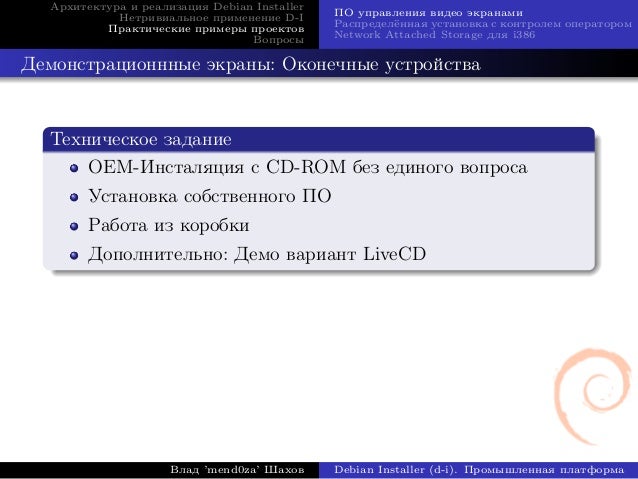Debian Installer Nfsroot

Introductionis an open-source database management system, commonly used as an alternative for the MySQL portion of the popular (Linux, Apache, MySQL, PHP/Python/Perl) stack. It is intended to be a drop-in replacement for MySQL and Debian now only ships with MariaDB packages. If you attempt to install MySQL server related packages, you’ll receive the compatible MariaDB replacement versions instead.The short version of this installation guide consists of these three steps:. Update your package index using apt. Install the mariadb-server package using apt.
The package also pulls in related tools to interact with MariaDB. Run the included mysqlsecureinstallation security script to restrict access to the server.
Debian Installer Nfsroot Windows 10
sudo apt update. sudo apt install mariadb-server.

Debian Installer Windows 10
sudo mysqlsecureinstallationThis tutorial will explain how to install MariaDB version 10.3 on a Debian 10 server, and verify that it is running and has a safe initial configuration. PrerequisitesTo follow this tutorial, you will need:. One Debian 10 server set up by following, including a non- root user with sudo privileges and a firewall.Step 1 — Installing MariaDBOn Debian 10, MariaDB version 10.3 is included in the APT package repositories by default. It is marked as the default MySQL variant by the Debian MySQL/MariaDB packaging team.To install it, update the package index on your server with apt:.
sudo apt updateThen install the package:. sudo apt install mariadb-serverThese commands will install MariaDB, but will not prompt you to set a password or make any other configuration changes. Because the default configuration leaves your installation of MariaDB insecure, we will use a script that the mariadb-server package provides to restrict access to the server and remove unused accounts.
Step 2 — Configuring MariaDBFor new MariaDB installations, the next step is to run the included security script. This script changes some of the less secure default options. We will use it to block remote root logins and to remove unused database users.Run the security script:.
sudo mysqlsecureinstallationThis will take you through a series of prompts where you can make some changes to your MariaDB installation’s security options. The first prompt will ask you to enter the current database root password. Since we have not set one up yet, press ENTER to indicate “none”.The next prompt asks you whether you’d like to set up a database root password.
Type N and then press ENTER. In Debian, the root account for MariaDB is tied closely to automated system maintenance, so we should not change the configured authentication methods for that account. Doing so would make it possible for a package update to break the database system by removing access to the administrative account.
Later, we will cover how to optionally set up an additional administrative account for password access if socket authentication is not appropriate for your use case.From there, you can press Y and then ENTER to accept the defaults for all the subsequent questions. This will remove some anonymous users and the test database, disable remote root logins, and load these new rules so that MariaDB immediately respects the changes you have made.
Step 3 — (Optional) Adjusting User Authentication and PrivilegesIn Debian systems running MariaDB 10.3, the root MariaDB user is set to authenticate using the unixsocket plugin by default rather than with a password. This allows for some greater security and usability in many cases, but it can also complicate things when you need to allow an external program (e.g., phpMyAdmin) administrative rights.Because the server uses the root account for tasks like log rotation and starting and stopping the server, it is best not to change the root account’s authentication details.
Changing credentials in the /etc/mysql/debian.cnf configuration file may work initially, but package updates could potentially overwrite those changes. Instead of modifying the root account, the package maintainers recommend creating a separate administrative account for password-based access.To do so, we will create a new account called admin with the same capabilities as the root account, but configured for password authentication.
To do this, open up the MariaDB prompt from your terminal:. sudo mysqlNow, we will create a new user with root privileges and password-based access. Change the username and password to match your preferences: MariaDB (none) GRANT ALL ON. TO ' admin'@'localhost' IDENTIFIED BY ' password' WITH GRANT OPTION;Flush the privileges to ensure that they are saved and available in the current session: MariaDB (none) FLUSH PRIVILEGES;Following this, exit the MariaDB shell: MariaDB (none) exitFinally, let’s test the MariaDB installation. Step 4 — Testing MariaDBWhen installed from the default repositories, MariaDB should start running automatically. To test this, check its status. sudo systemctl status mariadbYou’ll receive output that is similar to the following.
Output ● mariadb.service - MariaDB 10.3.15 database serverLoaded: loaded (/lib/systemd/system/mariadb.service; enabled; vendor preset: enabled)Active: active (running) since Fri 2019-07-12 20:35:29 UTC; 47min agoDocs: man:mysqld(8)PID: 2036 (mysqld)Status: 'Taking your SQL requests now.'